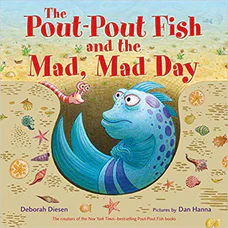The Pout Pout Fish and the Mad Mad Day
Written by Deborah Diesen
Illustrated by Dan Hanna
32 pages
•
Published 2021 (Farrar, Straus and Giroux)

Recommended Age Range: Preschool through 3rd grade.
Publisher's Summary:
The Pout-Pout Fish’s morning has been maddening and rough. Disappointments and frustrations―Mr. Fish has had enough! It’s been one thing, then another, then another stacked on top. He’s mad and getting madder. Is there any way to stop?

Dr. Annie's Takeaways
Recommended for: This fun rhyming story that’s a joy to read aloud helps children learn two anger management strategies to deal with a bad day: taking deep breaths and sharing about one’s feelings. It’s ideal for a child who needs a light touch when talking about these strategies (e.g., who might feel defensive or criticized with a more serious book).
Would a child like it? The Pout Pout Fish books are really fun, especially for kids who enjoy rhyming books with alliteration.
Tone: Upbeat, encouraging
Story Quality: The Pout Pout Fish books are so great at fitting legitimate psychoeducation
into rhymes that flow well and really pop. The author Deborah Diesen uses some words that children might not know (e.g., kerfuffle), but they’re fun words that might pique a child’s vocabulary curiosity. The Pout Pout Fish and the Mad Mad Day is both a good story and a joy to read aloud.
Illustrations: Expressive, attractive watercolor and pen cartoons of colorful under-the-sea life. The illustrations have lots of fun details that children can notice.
Representation: The Pout Pout Fish is a male fish, and his friends are different sea creatures (e.g., Ms. Clam, Mr. Jelly, Miss Shimmer, Mr. Lanturn).
Psychological Practices: Mr. Fish’s mad starts with a favorite souvenir breaking, followed by his inability to find glue to repair it. The repeated refrain of the story is “it’s been one thing, then another. Then another stacked on top” which is a great description of how anger often builds. The refrain is later applied to the use of multiple anger management strategies stacked on top of each other to help Mr. Fish reclaim his calm. Mr. Fish is skeptical that any of the strategies his friends teach him will help, but he tries them anyway, and by the end of the story he has calmed down. The strategies his friends teach him include taking deep breaths while counting to 10 and talking about what’s wrong (“When you’re hurt or feeling sad, disappointed, scared, or worried, those can channel into mad./ ‘The solution,’ said Miss Shimmer, ‘Is to talk about what’s wrong. Pick words for what you’re feeling. When you use them, you are strong’”).
Concerns: None.
